CP Rail's Sunbury Line
The following article appeared in the July, 1998 issue of Eastern
Railroad News; an internet magazine dealing with railroading east of the Mississippi River
(more or less). For more information about
ERN, check out their website. Reprinted with permission.
Although never known for large amounts of traffic, the Sunbury Line has long attracted
rail photographers to the scenic line following the East Branch of the Susquehanna River
in Pennsylvania. Originally a Pennsylvania Railroad interchange route, the Sunbury Line
runs from Sunbury, Pennsylvania to Wilkes-Barre. Typical of Eastern Pennsylvania, the line
traverses many small towns with colorful names: Riverside, South Danville, Catawissa, East
Bloomsburg, Mifflinville, Nescopeck, Wapwallopen, Mocanaqua, and Nanticoke.
The Sunbury Line has changed hands several times: it was
constructed by the PRR in the mid-nineteenth century to
interchange with the Reading Company, DL&W, and other
northeastern anthracite-hauling roads. Most interchange was done
at Buttonwood Yard south of Wilkes-Barre. DL&W traffic was mainly
interchanged with the PRR at Northumberland via the DL&W's Bloomsburg
Branch. Most of the interchange occurred at Buttonwood, with the D&H,
via the seven-mile long PRR/D&H jointly owned and operated
Wilkes-Barre Connectiong Railroad, which connected Buttonwood and Hudson
Yards, just north of Wilkes-Barre. The PRR also ran from Buttonwood
into Wilkes-Barre proper, interchanging with the Lehigh Valley and CNJ
as well as running passenger trains from there.
In 1968, the PRR was
merged with the New York Central to form the ill-fated Penn
Central. PC's ensuing bankruptcy caused a "Chapter 11 chain
reaction" throughout the northeast. Upon the failure of a
pro-competitive plan trying to include Erie-Lackawanna into the
Chessie System, Congress decided instead to grant Delaware &
Hudson trackage rights to Philadelphia, PA and Washington, D.C.
The D&H's southern terminus was then Wilkes-Barre, traversing a
mountainous route to Nineveh north to Albany and Montreal.
Congress thought that new trackage rights would strengthen the
D&H's position as a "bridge route" carrier.
On April 1, 1976 most trackage in the northeast was conveyed
to the Consolidated Rail Corporation, designed to save the
bankrupt roads and make them profitable as a unified system.
On "Day One", trackage rights were gained on three major
routes. The first was from Sunbury to Harrisburg PA to Perryville MD,
thence via Amtrak's Northeast Corridor to Potomac Yard at Washington
D.C. The second was from Scranton to Allentown, thence either to
Philadelphia or Oak Island Yard in Newark, N.J. Sometime in the
early 1980's, the former DL&W mainline from Binghamton to
Taylor Yard (near Wilkes-Barre), as well as the
former PRR Sunbury Line were conveyed to the D&H.
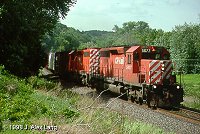
CP Rail train 555-29 heads northbound on CR's Buffalo Line
enroute to home rails at Sunbury on May 29, 1993. CP Rail SD40-2's 5677 and 5670 are
equipped with Locomotive Speed Limiting and Cab Signals for operation over Amtrak's
Northeast Corridor. |
The D&H generally operated one pair of trains over each of the routes through the
early 1980's when Guilford Transportation Industries acquired the D&H along with the
Boston & Maine and Maine Central railroads. The Sunbury Line remained active
throughout this period, with one pair of regular trains operating as well as occasional
extras. Trains had colorful, rainbow locomotive lashups, as units from Guilford, D&H,
MEC and B&M could be found as well as runthrough units from southern railroads such as
Chessie and Norfolk & Western. |
| The Guilford Era, although brief, brought other changes to the D&H's operations.
The operation of the three roads as one created a new virtual main line running from
Mattawamkeag, Maine to Sunbury, PA; a distance of approximately 700 miles. Through traffic
from Portland, ME to Washington, D.C. ran as POPY/PYPO. Operations via Allentown primarily
brought materials to the Bethlehem Steel plant in Bethlehem as well as interchange traffic
to Chessie at Eastside Yard in Philadelphia. D&H trains often interchanged traffic at
Conrail's Enola Yard near Harrisburg, PA. |
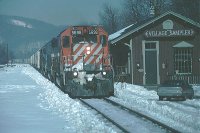
CP Phosphate Train 751-17 heads northbound by South Danville, PA on February 18, 1994 with
CP Rail SD40-2 5698 and three other SD40-2's including two GSCX units. Photo by Kevin
Burkholder. |
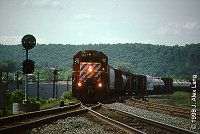
The same CP 555-29 viewed earlier enters CP Rail territory at
CP-Kase in Sunbury, PA. The train is leaving Conrail's Buffalo Line and entering the
Sunbury Line. |
Through 1987 and 1988, Guilford was trying to merge it's three railroads into it's
Springfield Terminal subsidiary. Railroad unions were not supportive of this move, as GTI
sought to reduce crew size, and introduce other conditions that the unions felt were
harmful. B&M and MEC were soon merged into ST (not without striking and arbitration),
but the D&H offered much resistance to GTI. At the time, D&H still had five-person
crews - Guilford sought to reduce this to two or three person crews. As a result of
difficulties involved with merging D&H into ST, Guilford declared D&H bankrupt and
effectively left the D&H on the doorstep of New York State. |
| The D&H shut down for several days after the
Guilford pull-out, causing much alarm with ICC and New
York State officials. Very shortly thereafter, the ICC
ordered the New York, Susquehanna & Western to
operate the D&H. Seeing the need for competition (as
well as an ally) in the Northeast, CSXT and Norfolk
Southern helped NYSW financially and operationally in
running the D&H. CSXT financed NYSW's purchase of 20
B40-8's which became quite well-known during the NYSW's
operation of the D&H. On the Sunbury line, traffic
dwindled to almost nothing. NYSW re-routed all through
trains to operate via Allentown. The only traffic on the
Sunbury line was the once-weekly TYEN/ENTY (Taylor to Enola),
and the line occasionally witnessed a GE transformer
high/wide load. |
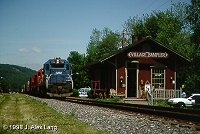
CP 555 picked up a GATX leased SD40-2 at Wolverton siding
since we last saw it. The train is passing the former PRR station at South Danville, PA.
This is one of the most well-known locations on the Sunbury Line. |
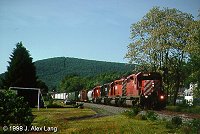
CP 556-28 heads southward through a bucolic scene typical of
the Sunbury Line and of Eastern Pennsylvania. 556 operated from Montreal to Washington
D.C, behind CP Rail SD40-2's 5690, 5678, 3254 (a former Norfolk Southern SD40-2B) and
5698. |
CP Rail was picked by the ICC and D&H Trustee
Francis DiCello to purchase the D&H in 1990. . CP's
presence was soon known throughout the D&H system,
operating it's bright red units everywhere. For awhile,
all through freights ran through Allentown, then Norfolk
Southern decided it wanted it's interchange traffic at
Washington D.C instead of via CSXT at Philadelphia. Soon,
CP Rail trains 555 and 556 (formerly known as PYRP and
RPPY) were scheduled to run via Sunbury. 555, 556, and
occasional unit phosphate trains ran via the Sunbury Line
from late January 1993 through March 31, 1996,
yielding these photos. During this time
period, there were few sidings, and train operations were
conducted via track warrants. Slow orders were in effect
throughout much of the line. Average track speed was
perhaps 40 mph. |
| Due to delays both on the Sunbury Line and Conrail's congested Harrisburg terminal
area, CP Rail again routed 555 and 556 via Allentown in 1996, removing all scheduled
trains from the Sunbury Line. The Sunbury Line has remained relatively inactive since that
time, however, it has proved it's usefulness more than once. The winter of 1995/1996
wreaked operational havoc on railroads throughout the northeast. A large washout on
Conrail's Lehigh Line (the route D&H trains use via Allentown, PA) caused CP to detour
4 through trains via the Sunbury line for over two weeks. During the summer of 1997,
trackwork on the Lehigh Line (by then owned by the Reading & Northern) forced CP to
re-route 555 and 556 via Sunbury again - but this time, the trains operated Scranton -
Sunbury - Harrisburg - Reading - Philadelphia to maintain their schedule and connections
with CSXT at Philly. Since last summer, however, the Sunbury Line has seen little traffic. |
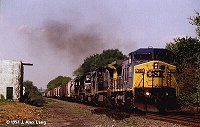
CP 556 passed through Palmyra, PA on Conrail's Harrisburg Line with CSXT 7680, CSXT 7694,
CSXT 6234, NS 9070, and NS3525 (2 CW40-8, GP40-2, C40-9W, B32-8. 556 was a real treat this
day, as NS power had been the lead of most D&H detour trains. However, the
Pennsylvania "potty" law - requiring chemical toilets - caught up with the
D&H; and CP Rail power was in the lead until these trains resumed their normal routing
via Allentown. |
Last year brought other interesting news for D&H operations. CSXT and Conrail
announced a friendly merger in October, 1996. NS and CSX then engaged in a counter-offer
battle that resulted in a plan to split Conrail evenly between them. Both roads sought to
get agreements in place with connecting and trackage rights railroads before
merger-approval hearings would be held. With the Conrail split-up approved in a voice vote
early in June, 1998, Conrail's system is slowly beginning to change.
Norfolk Southern last year negotiated an operations agreement with CP Rail that will
hopefully bring about a resurgence in traffic to the Sunbury Line. Since NS will receive
no Conrail trackage in or near New England, NS worked out a haulage agreement with CP Rail
and Guilford Transportation Industries. Through this agreement, CP Rail's interchange with
NS will be located at Harrisburg, PA (since NS is acquiring almost all former CR trackage
in Pennsylvania). Reportedly, NS will run at least six trains from Harrisburg to Albany
via Sunbury and Binghamton. Details are still sketchy, but it appears that the Sunbury
Line will become part of NS' major inland north-south intermodal route.
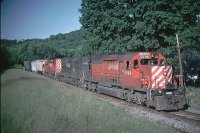
CP Train 556-01 is southbound approaching Kase and Conrail's Buffalo Line. This power set
consist was normal on the 555/556 during the 1994 operations to Potomac Yard. SD40-2 5698
followed by SD40-2B 3254, and SD40-2 5677 is at Sunbury on June 3, 1994. Photo by Kevin
Burkholder |
Tie work, resurfacing, and welded rail installation have been in progress on the
Sunbury Line for the last several months. Much work has been reported, especially in the
Wilkes Barre area, on increase of track speeds and repair of old track. The earliest NS
can begin control of it's portion of Conrail is August 23, 1998; so it could be quite soon
that hot intermodal trains ply the rails of the Sunbury Line. With CSX and NS soon
owning their own routes into the east and northeast, D&H's role as a bridge carrier
will certainly diminish. D&H, previously an ally in CSX' and NS' quest for access to
New York City, will not benefit from as much overhead traffic as before. Hopefully, the
new NS and CP Rail agreement can secure a place for D&H and the Sunbury Line in
northeastern railroading history. |
Update:
Details are still sketchy,
and the "Day-1" splitup of Conrail gets pushed back repeatedly, but the latest
as of March 1999 are that several trains will run via the Sunbury Line after "Day
1", projected to be June 1, 1999. Trains reportedly will include:
- Trains 154 and 155 will operate between Enola, PA and Mechanicville, NY
to a connection with Guilford.
- Trains 555 and 556 will begin operating during the month of May,
terminating in Enola, PA.
- Trains 557 and 558 WILL run via the Sunbury Line to Reading and
Philadelphia, not Allentown.
- Trains 265 and 266 will actually operate to New York City via CPR's
other trackage rights.
- Trains 272 and 273 will operate to Philadelphia-CSXT via Sunbury Line.
- All coal trains to the Bow plant will begin moving via the Sunbury Line
after June 1.
- Phosphate and acid moves will also be routed from Philadelphia, PA to
Harrisburg, then north over the Sunbury Line.
Two intermodal trains are planned for operation between NS in the south and
Guilford for delivery to New England. This is supposed to be direct
competition with CSXT New England traffic.
No trains are running via the Sunbury Line as of January, 1999 with
the exception of the P2 Taylor to Danville (Merck) local, any High-and-Wides for Conrail
interchange (there have been a few in 1999), and any inspection or maintenance trains.
Special thanks to Sam Scannella for assisting with corrections to this article.